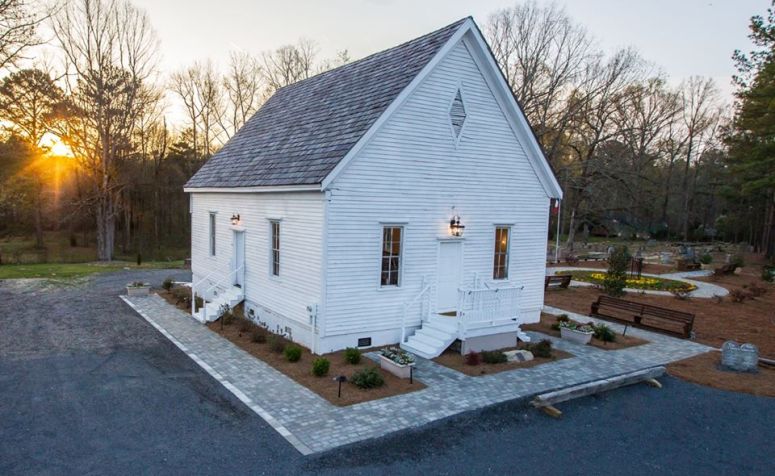 Article by Mark Wallace Maguire / Photography by Mark Wallace Maguire and courtesy of Hopeful Primitive Baptist Church
Article by Mark Wallace Maguire / Photography by Mark Wallace Maguire and courtesy of Hopeful Primitive Baptist Church
Hopeful Primitive Baptist Church was a cheerless building the first time I drove by it almost ten years ago.
The church looked abandoned. The paint was peeling.
The parking lot was a mix of gravel and clay. Pine trees and benign weeds choked the cemetery behind it.
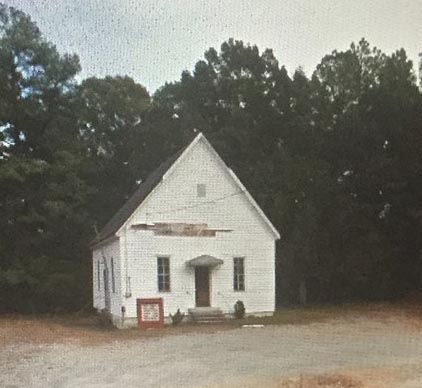
I should have stopped and asked about it.
But, then again, abandoned churches across the South are more common than we like to admit, and I tucked the urge away.
However, as I drove by the building every week over the next several years, I noticed change taking place.
A blue banner was hung outside that called for volunteers for restoration.
Then new paint was applied. A new roof. And the landscaping around the church was radically transformed as a brand-new fence was installed, as well as other hardscaping and hundreds of flowers and shrubs were planted.
Slowly, what was one of the saddest landmarks in the county, began to transform into one of the most iconic.
And though I admired the new visage of the church, I always wondered what was the impetus for the restoration? Did anyone still attend the church or was it just used for special events? What is the history of the building? And what might the future hold?
♦♦♦
Hopeful Church stands at the corner of Highway 92 and New Hope Road in northwest Fayette County. Opposite the church is a lot with thin pine trees and brush. Caddy corner stands an ominous water tower and, just north, sits the Hopeful Community Center. The church has been around longer than just about anything else in this part of Fayette. It was built in 1825, just four years after Fayette County itself was established.
On a Saturday afternoon several years ago, Issac ‘Griff’ Griffin was cleaning up the cemetery outside when he spied someone else in the graveyard.
That someone else was Dean Breest.
“I was standing out there and the leaves were pretty thick and I went down to my parents’ plot and Dean walked over and introduced himself,” Griff said. “We talked about the church and what it needed and the next Saturday he showed up with a rake and had a whole crew down here volunteering.”
That first Saturday of volunteer work was one of many that began a significant push to restore the church and its grounds. Slowly, over the next several years, with help and donations from dozens of community groups, a boy scout troop, individuals and businesses, the church was completely transformed and now stands as a shining example of what can happen when people come together for a common cause.
♦♦♦
Elder Tim Mullins has been pastoring at Hopeful for 34 years. Though born blind, Mullins has refused to let the malady stunt his life. He’s earned bachelor’s and master’s degrees and reads the Bible through Braille and audiobooks. He’s been married 28 years and on the first and third Sunday of every month, his wife Faye drives him some ninety-plus miles from Butler, Ga. so he can preach at Hopeful.
During the last three decades, Mullins has experienced the highs and lows of Hopeful. He’s seen the membership dwindle to two. He recalls when the county wanted to shut the church down because the building was deemed unsafe. And he has been grateful for the restoration of the structure.
“[Experiencing the church’s restoration] made me feel that God is not done with that little church yet. And since I’m there, He’s not done with my ministry yet. I don’t believe in retired pastors. My philosophy is if you can quit preaching, quit. But if you can’t, you need to keep going as long as health will let you,” he said.
In a day and age where worship services seem to be part laser show and part concert and clichés of tight-jeaned preachers are rampant, Mullins does not shy back from talking about how services are unique at Hopeful. A matter of fact, he relishes in sharing.
The focus at Hopeful is on serving, Mullins said. Though Mullins studies the Bible every morning, he doesn’t prepare a specific sermon for Sunday. Rather he lets the Spirit lead him.
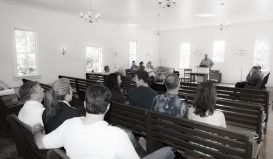
“What if your mind has changed before the service or a church member tells you they are struggling with something? Then if you stick to what you wrote, you are preaching from a card and not from your heart,” he said.
The church also doesn’t have a formal set of hymns to sing each Sunday. Attendees will call out a hymn they want to hear and Mullins, whose next goal is to memorize the entire church hymnal, leads the singing in church as well. There is no organ or other instruments and songs are sung acapella. You also won’t find any microphones, not that they are needed as the acoustics inside are naturally gorgeous.
Though the average attendance on Sundays is around a dozen, Mullins enjoys the smaller size of his congregation.
“With a smaller church you can talk to your members. And people can tell you the problems they are having. Everybody knows each other and fellowships with each other,” he said.
♦♦♦
Hopeful’s cemetery is testament to its longevity. There are graves from veterans of the Revolutionary War, The Civil War and the first two world wars. Recent discoveries include what may be slave and Native American graves.
The structure itself has weathered the decades quite well and its longevity is a testament to the talent of the men and women who helped build it. The boards underneath the floor are original. The walls and ceiling are original. The church still doesn’t have or centralized heat or air conditioning and the pot-bellied stove that used to warm the room on winter mornings has long been removed.
♦♦♦
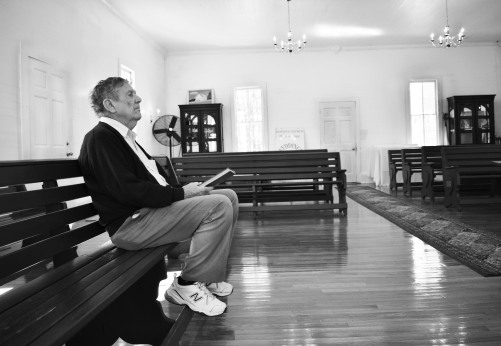
Griff’s familial roots run deep in the church.
His grandmother is buried in the cemetery next to her first and second husbands. Griff’s mother – who died four years ago at 103-years-old – is buried there. All in all, Griff has over half a dozen family members in the graveyard.
In a recent interview inside the church on a chilly winter morning, Griff shares stories past and hope for the future. An electric fire is chattering beside us and through the windows, the last of the last fall’s leaves are shivering in a fierce February wind.
“My Grandmother sat there,” he says pointing to an empty space on the first row of pews in the church. “I can see her sitting on that bench, I can see her standing in that door.”
Griff recalls how, growing up, the ladies all sat on one side of the church and the men at the other. At the end of each pew was a spittoon and at the center of the church was a pot belied stove fired by coal.
He remembers how the church was a centerpiece of the area.
“I’ve seen this church with every seat occupied and us feeding the whole community.”
He’s also seen the community change and the church’s presence decline, but he is hopeful.
“I’ve seen the light in this church get mighty, mighty low, but it’s still survived. If it had not been for that man there,” he said pointing to Dean, “this church wouldn’t be here.”
Breest, who didn’t care to have his portrait made for this article, continually shrugs off the praise and instead readily reels off names of volunteers and companies which have donated time and material to the restoration through the years.
But Breest is quick to mention that the work isn’t done. There are still funds to be raised. Plans are underway for a fellowship hall. And, most important of all, is getting the church recognized as a national historic site.
When that happens, the church will be preserved under federal law.
In other words, residents like Griff won’t have to worry about a convenience store cropping up next to the graves of their forefathers.
♦♦♦
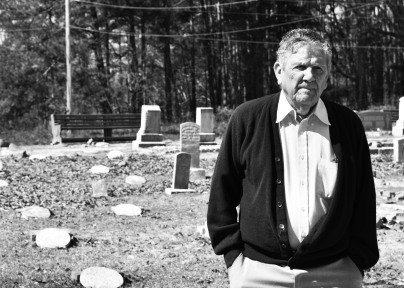 The wind is picking up and Griff agrees to take another stroll across the grounds and pose for a few more photos. His gait is trepadatious over crooked ground and his expression is solemn. But, don’t expect a rueful observation from him when asked how he feels about the restoration at Hopeful Church.
The wind is picking up and Griff agrees to take another stroll across the grounds and pose for a few more photos. His gait is trepadatious over crooked ground and his expression is solemn. But, don’t expect a rueful observation from him when asked how he feels about the restoration at Hopeful Church.
“I wish those people who are 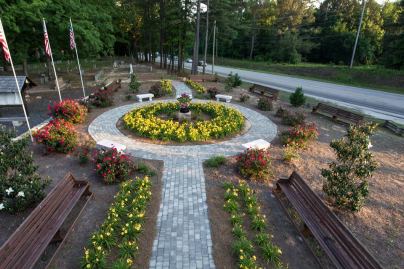
buried out there could see it, I can’t believe what’s been done. It makes me happy for my mother.”
Services are at 11 a.m. the first and third Sunday of the month and last about an hour. The church welcomes visitors. If you want to contribute or volunteer, you can contact the church via their facebook page here
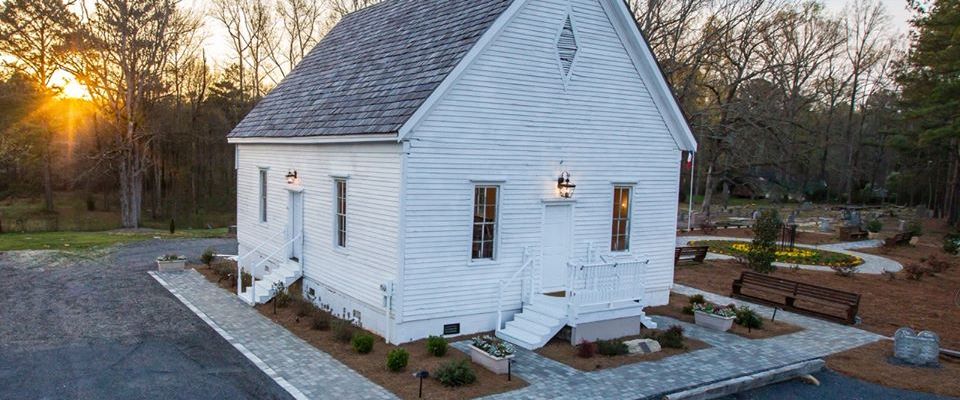








Do you know the names of the Revolutionary War soldiers?
LikeLike
Tony, I do not, but if you contact the church, I am sure they can help you. Best,
LikeLike